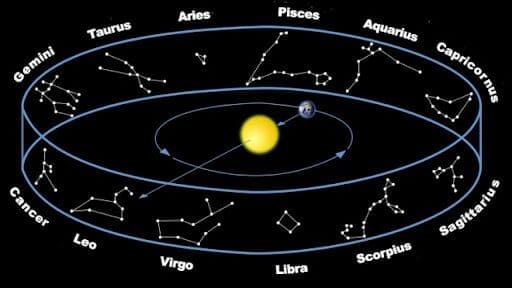
Humans have always been fascinated with the shiny objects in the sky. The significance of celestial objects visible in the sky has been assigned to them since humanity first wandered the Earth. Names and mythical stories have been ascribed to patterns in the night sky throughout human history and throughout many civilizations, giving rise to what we now know as constellations. The constellations seen at night are determined by your location on Earth and the season. Constellations were given names based on things, animals, and humans long ago. Constellations are still used by astronomers today to label stars and meteor showers.
What are Constellations?
A constellation is a group of stars that have been given a name and resemble a specific shape in the sky. These stars are a long way away from our planet. They have no resemblance to one another. Some stars in a constellation are close together, while others are far apart. However, if you used your imagination and drew lines in the sky between the stars like a dot-to-dot jigsaw, the picture would resemble an object, animal, or human.

Depending on what individuals thought they saw, many cultures worldwide have given constellations different names and numbers over time. There are currently 88 constellations that have been officially recognized
Location and Visibility
The constellations are seen at night change depending on the season. Once a year, the Earth orbits the Sun as we orbit it; our vision of space via the night sky changes. Every night, the stars appear to travel westward from where they were the night before. Earth is in a different spot each night; the night sky looks slightly different. The time of day has a significant impact on how much sky you can view, no matter where you are. Because the Sun only shines for about half of the day, you can’t see constellations that are obscured by the Sun.
Furthermore, because the Earth orbits the Sun, different sections of the sky can be seen depending on the season. Even still, depending on which hemisphere you live in, there are some things you can’t see at all. This explains why eclipses, meteor showers, and other natural occurrences are only visible in particular portions of the globe.
What stars and constellations you see are determined by your location on Earth. The Northern Hemisphere always faces the opposite direction as the Southern Hemisphere. Therefore, people in New Zealand see an entirely different sky than those in Canada.
Easy To Spot Constellations
Ursa Major
Looking for the Big Dipper asterism is the most straightforward approach to finding Ursa Major. This is the most easily recognized constellation, which resembles a huge spoon or possibly a wheelbarrow. The constellation Ursa Major is visible all year from most of the northern hemisphere and looks circumpolar over and above mid-northern latitudes. The primary big dipper asterism is invisible from southern temperate latitudes; however, the southern sections of the constellation can still be seen.

Orion
Orion is also one of the most easily recognized constellations in the night sky. Begin by looking for the three bright stars that form the straight line of the hunter’s belt. You should be able to see Betelgeuse, a shining star that forms the hunter’s armpit, from there, and follow it east down the hunter’s arm, which is holding a bow. Other stars fill in the rectangle of the hunter’s upper body, and you should be able to see the hunter’s sword hanging from his belt if you look closely.

Crux
The Crux is one of the easiest constellations to recognize. It fills in a bright section of the Milky Way, centered on four stars in the southern sky. It is, however, the tiniest of the 88 constellations, covering only roughly 68 square degrees. The Southern Cross, created by the Crux’s five brightest stars, is one of the easiest constellations to find because of its prominent cross-shaped asterism. The brightest star in the constellation is Acrux, Alpha Crucis, which has six named stars.

Zodiac Constellations
Constellations that lie along the ecliptic plane are known as zodiac constellations. The ecliptic, or Sun’s apparent route through the sky as seen from Earth, is defined by the Sun’s circular path across the sky. In other words, the Sun appears to travel through these constellations during a year. The Sun’s journey across the zodiac is a cycle ancient cultures utilized to identify the seasons.

In the zodiac family, there are 12 constellations. They’re all visible across the ecliptic. The zodiacs are Aries, Taurus, Gemini, Cancer, Leo, Virgo, Libra, Scorpio, Sagittarius, Capricornus, Aquarius, and Pisces constellations. The northern zodiac constellations – Pisces, Aries, Taurus, Gemini, Cancer, and Leo – are in the eastern celestial hemisphere, while the southern zodiac constellations – Virgo, Libra, Scorpius, Sagittarius, Capricornus, and Aquarius – are in the western celestial hemisphere.
Known stars can also be utilized to navigate, such as those in well-known constellations. Sailors have used stars to pinpoint their whereabouts at sea for millennia. Celestial navigation is the term for this. Astronauts have also been trained to use celestial navigation as a backup if modern navigation technologies fail. Constellations form the map of the skies.
They have functional as well as recreational importance. Trying to spot constellations in the night sky really adds five stars to stargazing (pun intended).

Be the first to comment